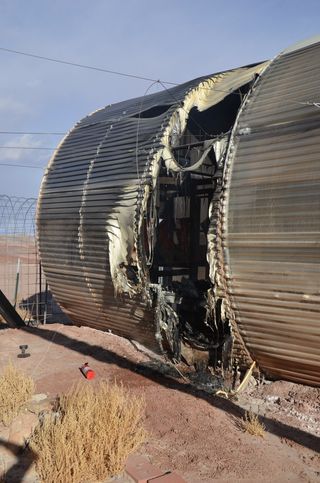Indiegogo Campaign Seeks Funds to Rebuild 'Mars' Greenhouse

The Mars Society has launched a crowdfunding campaign to help rebuild its greenhouse at a facility in rural Utah that was destroyed by a fire last December.
The "GreenHab" at the Mars Desert Research Station (MDRS) was deemed unfit for use after a fire erupted during a mock Mars mission in late December 2014. Crewmembers fought the fire and limited the damage. The cause was an electrical heater, and the incident was ruled an accident.
The GreenHab team spent several months designing a new greenhouse and clearing the site for the new structure. Now, The Mars Society, a nonprofit group that aims to further manned exploration and settlement of the Red Planet, says it needs $10,000 to buy components — such as lights, fans, sensors and environmental controls — for the new greenhouse. [Mock Mars Mission Photos: Life on a Simulated Red Planet]
So, on July 30, the group launched a campaign via the crowdfunding site Indiegogo. With 28 days to go, The Mars Society has raised about $3,600 of its $10,000 goal.
"All the things for plants — for food growth and plant-science studies — we are doing the fundraising campaign to support purchasing that equipment," Nick Orenstein, MDRS GreenHab coordinator and (coincidentally) the commander of the crew that fought the fire, told Space.com.

A previous, undisclosed amount was raised from Mars Society donations for the new structure itself, Orenstein said. In January, MDRS Director Shannon Rupert told Space.com that a replacement structure would cost $40,000 but that she was hoping to reduce it to $10,000 through volunteer labor.
If the fundraising goal is not reached, MDRS will continue with the current arrangement: a temporary tentlike greenhouse that can host some experiments.
Get the Space.com Newsletter
Breaking space news, the latest updates on rocket launches, skywatching events and more!
The new GreenHab will be a dome roughly 25 feet (7.6 meters) in diameter at its widest point. It is set up fairly close to where the old one was located, but in an area that will better accommodate the new structure, Orenstein said.
Not only is the dome structurally efficient, but the fans can be placed more evenly than in a rectangular building, he added. Winds on the site would also curve a little better across the circle than they would on a flat surface.
GreenHab team members visited the site last week to clear away the last of the old structure and to prepare the site for the new one. The next major step is to pour concrete slabs to house the dome. A local contractor in nearby Hanksville, Utah, who did similar work for the site's observatory, will perform the work this month, Orenstein said.
If the money is raised in time, the structure and its components would be completed in September. The 2015-2016 field season for MDRS runs from October to May, with crews spending two-week rotations on the site.
To learn more about the campaign, visit the Indiegogo site at https://www.indiegogo.com/projects/veggies-on-mars-help-rebuild-the-mdrs-greenhab#/story
Follow Elizabeth Howell @howellspace, or Space.com @Spacedotcom. We're also on Facebook and Google+. Originally published on Space.com.
Join our Space Forums to keep talking space on the latest missions, night sky and more! And if you have a news tip, correction or comment, let us know at: community@space.com.

Elizabeth Howell (she/her), Ph.D., is a staff writer in the spaceflight channel since 2022 covering diversity, education and gaming as well. She was contributing writer for Space.com for 10 years before joining full-time. Elizabeth's reporting includes multiple exclusives with the White House and Office of the Vice-President of the United States, an exclusive conversation with aspiring space tourist (and NSYNC bassist) Lance Bass, speaking several times with the International Space Station, witnessing five human spaceflight launches on two continents, flying parabolic, working inside a spacesuit, and participating in a simulated Mars mission. Her latest book, "Why Am I Taller?", is co-written with astronaut Dave Williams. Elizabeth holds a Ph.D. and M.Sc. in Space Studies from the University of North Dakota, a Bachelor of Journalism from Canada's Carleton University and a Bachelor of History from Canada's Athabasca University. Elizabeth is also a post-secondary instructor in communications and science at several institutions since 2015; her experience includes developing and teaching an astronomy course at Canada's Algonquin College (with Indigenous content as well) to more than 1,000 students since 2020. Elizabeth first got interested in space after watching the movie Apollo 13 in 1996, and still wants to be an astronaut someday. Mastodon: https://qoto.org/@howellspace
